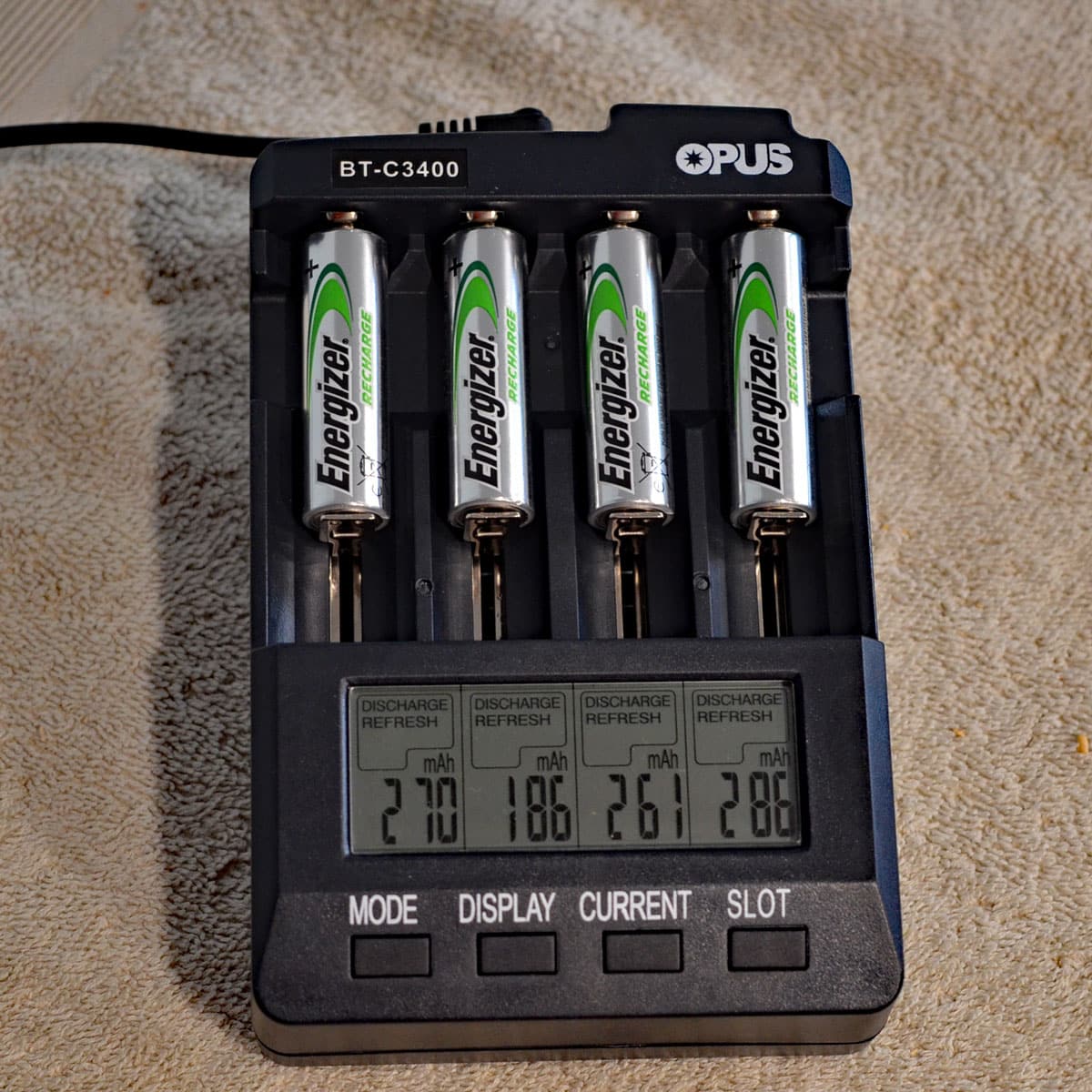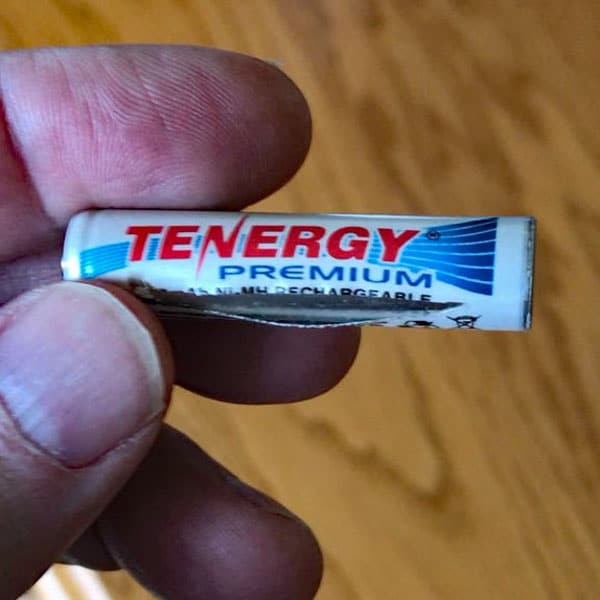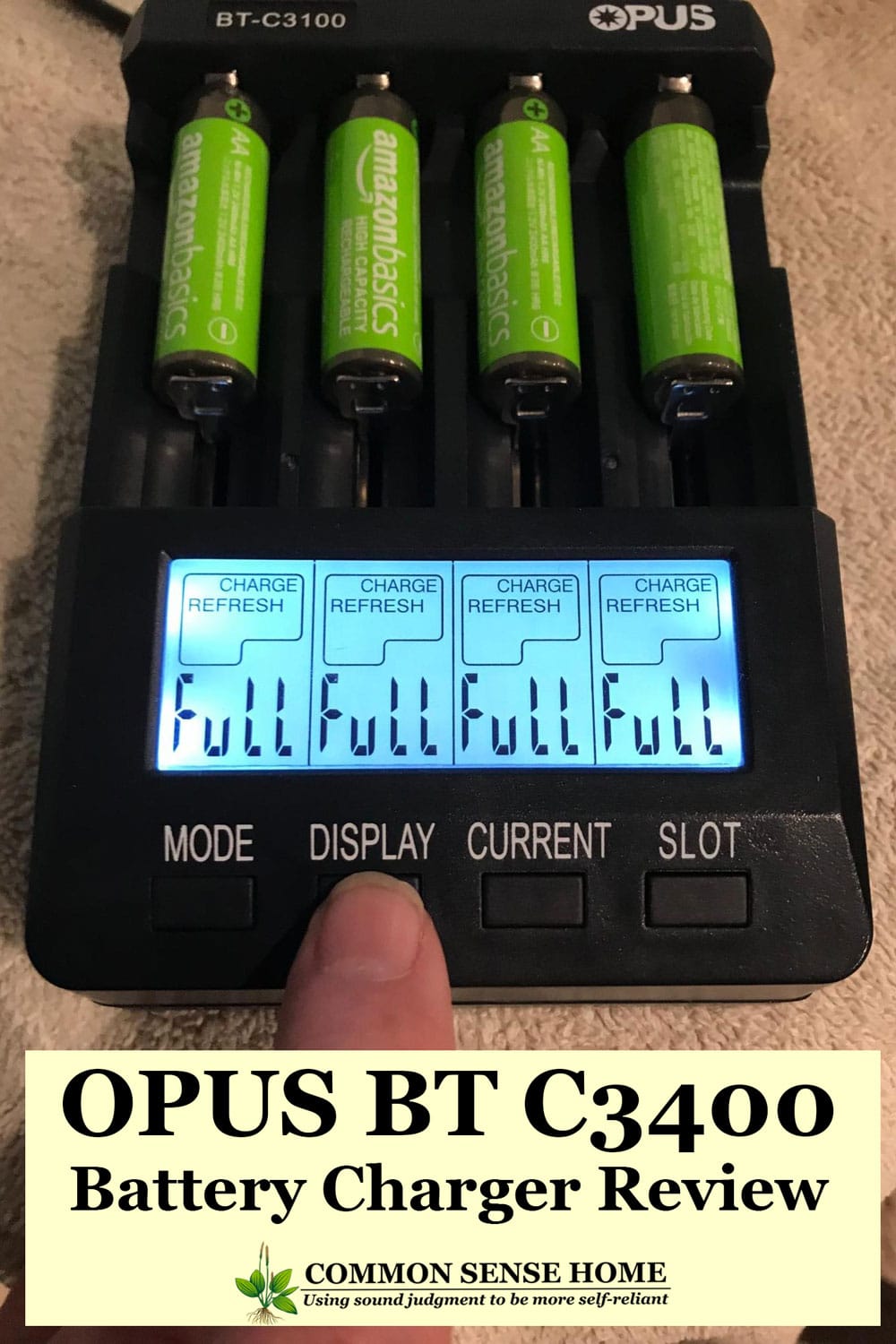OPUS BT C3400 Battery Charger Review
This post may contain affiliate links. Read my full disclosure here.
The OPUS BT C3400 Battery Charger is a great charger. It is easy to use – plug it in, insert batteries, select mode and it starts charging. The LCD display is backlit when you select menu options, which makes it easy to read.

Table of contents
- Opus C3400 Summary
- Using the OPUS BT C3400
- Opus C3400 Modes
- Discharge Refresh Mode
- C3100 and C3400 Controls
- Charging Rate
- Internal Resistance (IR)
- Sound, how much noise does it make?
- Other OPUS BTC3400 Info
- What is the difference between the OPUS BT C3100 and C3400?
- Alternatives to the OPUS BT C3400
- RELATED ARTICLES
Opus C3400 Summary
The C3400 is a 4bay A/C powered battery charger that supports nearly all common battery types. It can recharge up to four 1.2 volt NiMH/NiCd cell sizes: AAAA, AAA, AA, A, C and SubC.
It can also charge 3.7 volt Li-ION cell sizes: 10340, 10440, 14500, 14650, RCR123A (17340), 17500, 17670, 18350, 18500, 18650, 19670 (protected 18650), 25500, 26500, 26650 rechargeable batteries.
The mAh rating appears to be a bit more conservative/realistic than the other AAA and AA battery chargers. Also, the final mAh/mWh variance between individual charged batteries was lower than other AA/AAA chargers, such as the XTAR VC4S, VC8 Plus and PowerEx MH-C980.
It is powered by a 12v AC power adapter (included) or 12v car plug (included). It does NOT have a USB port.
Using the OPUS BT C3400
The modes are easy to select and intuitive. (I didn’t read the manual until AFTER using it.) Simply slide your battery in, pick your mode and you are set to go.
There are no tricks to inserting AA, AAA, 18650 or other batteries. You might need to press the battery down into the slot a bit, but the batteries generally seat very well.
NOTE: Make sure NiMH cell or Li-ION cell is positive “up” and negative “down”. Although rare, it is possible for batteries to leak or explode if placed in a charger backwards.
You can mix charging 3.7v Li-Ion batteries and 1.2v NiMH batteries in the same charging cycle.

It is has an easy to read LCD display. My eyesight isn’t great, and I can read it easily, especially with the backlighting. After you press one of the buttons, the LCD screen lights up for about 20 seconds.
If a displays shows NULL with a battery in, that battery is dead, or so discharged that the OPUS cannot charge it. (You could try to put that battery in another charger, just to make sure.)
The maximum discharge is 1000mA for LiIon and 700mA for NiMH. We don’t use the variable charge rates (current), but the option is available. We let the device auto detect and use default current and settings.
Opus C3400 Modes
The OPUS BT C3400 AA/AAA battery charger has 5 modes: Charge, Discharge, Discharge-Refresh, Charge-Test and Quick Test.
- CHARGE: Charge battery with 200, 300, 500, 700 and 1000 (2000) milliamp
- DISCHARGE: same rates for charge in reverse.
- DISCHARGE REFRESH: Discharges then recharges the battery three times. The discharger-refresh automatically cycles 3 times
- CHARGE TEST: Charges then discharges and charges the battery. It will show discharge current. Great to determine if a battery should be retired (after discharge-refresh).
- QUICK TEST: Measures the IR (internal resistance). IR is another way to see if a battery is getting old or needs to be retired.
The charger will default to the charging mode.
Discharge Refresh Mode
The DISCHARGE-REFRESH mode is excellent. We used it to successfully recondition old AA and AAA NiMH 1.2v batteries. It was obvious which batteries needed to be retired and recycled, as they either read “off” or crack the casing.

The Discharger-Refresh mode is also great conditioning new NiMH AA and AAA batteries. It will cycle batteries; charging, then discharging, and then charging again.
This is important, because most rechargeable batteries require a number of charges and discharges to reach their full runtime capacity. When testing rechargeable batteries, I saw increase of 13-31% over time compared to the initial charge.
Test Modes
As noted above, there are 3 different test modes – (1) DISCHARGE/REFRESH, (2) CHARGE TEST and (3) QUICK TEST. We regularly used the DISCHARGE/REFRESH because of the charge and discharge testing.
C3100 and C3400 Controls
The MODE button does exactly what you think – switches between modes.
The DISPLAY button will rotate through the display including showing battery voltage, charge or discharge wattage, elapsed time and status.
The CURRENT button can change wattage for charge/discharge.
The SLOT button allows you to select individual slot settings in case you are charging dissimilar batteries, or want different settings per slot.
Charging Rate
Depending on the specific battery and charge rate, it can take 1.5 to 10+ hours to charge the batteries. It will take even longer if you do DISCHARGE-REFRESH, because it must fully discharge.
Would you like to save this?
Charge time is similar to the other 4 chargers we tested for the various batteries. Because it is an A/C powered charger you don’t have USB wattage limitations – BUT the lack of USB input limits it to AC or 12v inputs.
We noticed that display will show that the battery is “FULL” but the capacity still goes up very slowly. The number might change a tiny bit while the charger is doing its final trickle charging of that battery.

Internal Resistance (IR)
Internal Resistance (IR) is one of the things the charger measures. A low number is good, a high number is bad. If the IR is greater than 1500 the battery is likely at the end of its life.
A good range for a high draw device is 20 to 80 mill-ohms. If IR is greater than 500 for NiMH or 175 for Li-Ion, that battery should probably be used only in low draw devices, such as: wireless mouse/keyboard, clock, TV remote etc.
Remember the “Quick Test” is just that – a quick test that is only roughly accurate. Do the quick test several times (preferably after a charge). Take the average of a few tests to see if the battery needs to be retired or restricted to low draw use.
Sound, how much noise does it make?
The OPUS C3100 is somewhat loud, but less noisy than our PowerEx MH-C980. The newer OPUS C3400 has a new fan and makes even less noise than either the Powerex or C3100. Regardless, we don’t recommend placing a battery charger in a bedroom or living space due to the noise.
The battery charger fan is necessary to keep the batteries cool. The fan cycles with the heat/load on to or from the batteries. The XTAR V4S and Nitecore charger fans are also more quiet than the Powerex.
Other OPUS BTC3400 Info
The C3400 does not have a USB power source and cannot charge USB devices. It does NOT support charging 1.5v Li-Ion AA/AAA batteries, but neither do the XTAR Dragon and MC3000.
Currently, 1.5v AA Li-ION batteries require a CUSTOM charger that matches the batteries. Odds are universal chargers will eventually support 1.5v Lithium Ion AA/AAA, but they don’t right now.
We do NOT recommend the OPUS BT 2400 because it doesn’t charge Lithium Ion batteries.
Don’t leave batteries in a charger after they are charged, as it will discharge them faster than than them being stored.
What is the difference between the OPUS BT C3100 and C3400?
We have both the OPUS BT-C3100 V2.2 and OPUS BT-C3400, and they both work well. The BT C3100 and C3400 are quite similar, but the C3400 has updated firmware and a better fan. We recommend getting the C3400 to get the slightly better features.
Alternatives to the OPUS BT C3400
We suggest two USB powered alternatives, the Nitecore or the XTAR VC4SL. Both are reliable and have some nice features.
The XTAR VP4 PLUS DRAGON is the slightly more expensive next step up. It has a volt meter and more advanced features. Notably, it has the cool option that it can function as a 3.7v battery USB powerbank.
The SkyRC MC3000 is the best charger on the market right now. But beware, it has a serious menu and has so many features that there are groups dedicated to what it can do. It is A/C powered and the most expensive of all the chargers.
CONCLUSION
Common Sense Home rating: Functional, Reliable and Absolutely Recommended.
We highly recommend the OPUS BT 3400 charger. The 3100 is great also (we have both), but the 3400 is a bit less noisy. We have charged hundreds of batteries and both have done an excellent job.
The 3100/3400 have recovered old oddball batteries and improved power storage on them. We have not had problems with overheating and it is a simple, reliable workhorse.
REFERENCE LINKS
- The OPUS BT C3400 manual.
- Excellent Highly Technical Review of previous model 3100 from lygte-info.dk. The 3100 is very similar to the 3100.
- Candlepowerforums review of the BT C3100 (older model with louder fan)

RELATED ARTICLES

This post was written by August Neverman IV. August has a strong background in emergency preparedness. He served on several emergency preparedness teams during his tenure at Brown County WI Government, the Medical College of Wisconsin, HSHS, a 13-hospital system and emergency response training during his time with the Air Force and Air National Guard. Learn more about August.


The OPUS BT-C3400 would be almost perfect for me if it only supported charging and testing 1.5V Li-Ion. That’s a pretty big lacking feature that this and other top ones are still missing.